A DLS experiment yields an estimate of the distribution of size of molecules in the sample. Widely used to evaluate structural homogeneity of protein samples, e.g., large changes in oligomerization or to detect aggregation under different buffer conditions. Can be also used to follow time dependent size changes (e.g., large oligomerization reactions such as fibre formation). The translational diffusion of molecules in solution is determined from fluctuations in light scattered from a small volume as the number of molecules in that volume changes over a short time. This measurement is converted to a hydrodynamic radius of the sphere that will diffuse at the same rate.
What are the sample requirements?
- Pure samples are preferred.
- Required sample concentration is strongly dependent on molecular size. A typical concentration is (10/molecular weight in kDa) in mg/mL, i.e., about 1 mg/mL for a 10-kDa particle and 0.1 mg/mL for a 100-kDa species.
- Single sample instruments require a sample volume of 5 to 15 μl (pUNK, Unchained; DynaPro plate reader III, Wyatt) or 30 μl (Zetasizer, Malvern Panalytical), which also has the option of measuring motion in an electric field (electrophoretic mobility) and the electrostatic repulsion between charged particles (zeta potential).
What other specific considerations are relevant?
- If the aim is to measure hydrodynamic radius, the sample should be free of aggregation, which will otherwise dominate the scattering. To avoid the effects of dust particles, filtering of buffer is required (0.02-0.1 μm pore size syringe filters).
- A very large range of molecular sizes (<1 nm to 10 μm) can be estimated. However, because larger species scatter much more than smaller, the presence of any substantial amount of a very large species can completely hide a small species.
- Size resolution is relatively low compared to a (much more complex) AUC experiment, or to a static light scattering measurement. Typically, a greater than two-fold difference in size is required to distinguish molecular species.
Partners offering this technique
MOSBRI reference partner site for this technique:
Other partners:
